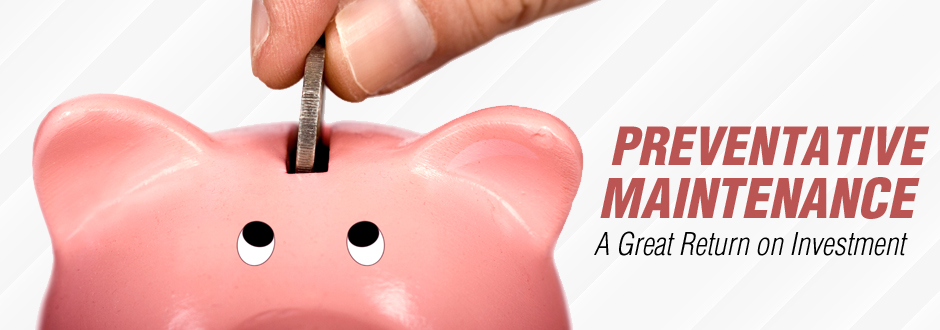Wasp Barcode Technologies: The Barcode Solution People
Preventative Maintenance on Fixed Assets: A Great Return on Investment

In most industries, operational effectiveness depends on a major investment in
fixed assets such as vehicles, specialty tools and machinery, custom equipment, and other mechanical devices. Shown on the balance sheets as fixed assets, these items can represent a large portion of a company’s value.
However, even if those assets are fully depreciated from an accounting perspective, they are often essential to maintaining efficient operations. Productivity is a function of how efficiently a company maintains its operations flowing smoothly and at the lowest cost.
The concept of preventative maintenance is a well-known and accepted aspect of keeping equipment in the best possible working order. Unfortunately, many companies fail to adopt effective preventative maintenance policies and programs and incur needless expenses, work delays, and safety issues.
When the discussion of preventative maintenance is held among managers, many common sense observations come to the forefront:
- It keeps repair costs down
- It helps avoid downtime
- It avoids customer problems when products can’t be delivered on time
- It will extend the life of the equipment

While those are all true and feel right, the problem with preventative maintenance is often a lack of insight into what that means in dollars and cents. For example, how do you know what the real and soft costs are of a vehicle breaking down and 20 customers not getting their deliveries on time? Or, the projected cost of an assembly line being down for several hours while a new bearing is located, delivered, and installed?
Even more abstract is calculating the value of gaining an additional 20 percent in lifetime use of an expensive stamping machine. If it costs $100,000, spending a few hundred dollars a quarter is a sure way to receive significant return on a small investment.
The Building Owners and Managers Association found in one of its surveys that building managers estimated as much as
15 percent of their budget goes to repairs and maintenance, with as much as 30 to 50 percent going to preventative maintenance expenses. While it might be tempting to shave a few of those dollars off an annual budget, a study by Jones Lang Lasalle show this is a short-term savings with long-term consequences that are much more expensive from several perspectives.
In just one analysis, the use of effective preventative maintenance on a $33,000 compressor netted an annual savings of $6,359 in direct costs of repairs and soft costs in extended usable life (EUL). In fact, most HVAC manufactures quote studies that show effective preventative maintenance on their units will eliminate 90 percent or more of unscheduled breakdowns. Just one such breakdown in the extremes of the heat of summer or cold of winter can cost more than 10 years of preventative maintenance.
According to the extended study, returns vary from industry to industry. However, the ROI can be as high as 500 percent or more, especially where such sensitive equipment as healthcare and transportation are involved.
While it is important to understand the financial aspects of preventative maintenance, there are other significant factors that support maintaining an aggressive policy. In the hyper-competitive environment, anything that helps avoid disappointing customers is a competitive advantage.
Other factors include:
- Safety. One of the first items OSHA and personal injury lawyers ask for when a worker is injured or killed is equipment maintenance records. Any failure to properly maintain and repair equipment is seen as negligence. Aside from the legal concern, of course, is the desire to create the safest work environment possible. The airline industry is expected to set the gold standard for such policies because of the direct correlation of safety to proper maintenance. In fact, the lessons learned from the airline industry in keeping highly sophisticated aircraft safely flying has helped transform the entire attitude toward systematic preventative maintenance.
- Productivity. As noted above, the first advantage of preventative maintenance is avoiding expensive downtime. However, the impact on productivity is much greater than this one aspect. It includes equipment running at the lowest energy cost and highest output, improving quality control, minimizing operational strain on equipment, and increasing operator effectiveness. The soft value of employees seeing management providing the best possible and safest work environment is also significant.
- Branding. Customers expect reliability and consistent performance. Whether it is a delivery truck, a printing press, or a dental drill, they don’t expect to be inconvenienced by unscheduled repairs and downtime. In today’s modern world, an investment in preventative maintenance is an inexpensive form of insurance for your brand.
- Using the Available Resources

Once management fully buys into the importance of preventative maintenance programs, they are often at a loss as to how to most effectively implement them. Fortunately, there are efficient and affordable resources to help make that goal achievable.
Wasp Barcode Technologies provides
asset tracking solutions that facilitate the management of all your assets: IT equipment, tools, vehicles and much more. We’re known for tailoring solutions to meet exacting standards for the most sophisticated equipment and demanding environments.
We can show you how a modest investment in our asset tracking capabilities will generate significant ROI.
Schedule a live demo today!
 In most industries, operational effectiveness depends on a major investment in
In most industries, operational effectiveness depends on a major investment in  While those are all true and feel right, the problem with preventative maintenance is often a lack of insight into what that means in dollars and cents. For example, how do you know what the real and soft costs are of a vehicle breaking down and 20 customers not getting their deliveries on time? Or, the projected cost of an assembly line being down for several hours while a new bearing is located, delivered, and installed?
Even more abstract is calculating the value of gaining an additional 20 percent in lifetime use of an expensive stamping machine. If it costs $100,000, spending a few hundred dollars a quarter is a sure way to receive significant return on a small investment.
The Building Owners and Managers Association found in one of its surveys that building managers estimated as much as
While those are all true and feel right, the problem with preventative maintenance is often a lack of insight into what that means in dollars and cents. For example, how do you know what the real and soft costs are of a vehicle breaking down and 20 customers not getting their deliveries on time? Or, the projected cost of an assembly line being down for several hours while a new bearing is located, delivered, and installed?
Even more abstract is calculating the value of gaining an additional 20 percent in lifetime use of an expensive stamping machine. If it costs $100,000, spending a few hundred dollars a quarter is a sure way to receive significant return on a small investment.
The Building Owners and Managers Association found in one of its surveys that building managers estimated as much as  Once management fully buys into the importance of preventative maintenance programs, they are often at a loss as to how to most effectively implement them. Fortunately, there are efficient and affordable resources to help make that goal achievable.
Wasp Barcode Technologies provides
Once management fully buys into the importance of preventative maintenance programs, they are often at a loss as to how to most effectively implement them. Fortunately, there are efficient and affordable resources to help make that goal achievable.
Wasp Barcode Technologies provides 

